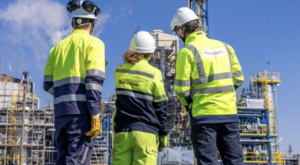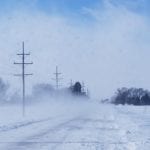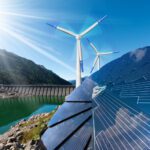Hurricanes are the leading cause of power outages in the U.S. Power outages can make storms exponentially more dangerous for local populations, especially if they affect critical facilities like hospitals, fire stations, and police departments, which are vital in times of crisis.
But what can utilities and municipalities do to prepare for natural disasters? How can they keep essential services and infrastructure up and running in the face of a hurricane? Preparing an advance strategy for deploying temporary power solutions is key to “weathering the storm.” Looking at how such solutions were utilized in New Orleans during Hurricane Ida can reveal valuable lessons about facing similar power challenges in the future.
Weathering the Storm
On August 29, 2021, Hurricane Ida, the second-most destructive hurricane in Louisiana history, made landfall near Port Fourchon as an “extremely dangerous” Category 4 storm with sustained winds of 150 mph, on the verge of being a Category 5 storm (157 mph winds), Ida furiously turned inland with catastrophic winds, heavy rainfall, tornadoes, flash and urban flooding, and life-threatening storm surge along the coasts of Louisiana, Mississippi, and Alabama.
This impact devastated Louisiana’s power grid, damaging more than 30,000 utility poles, close to 35,000 spans of wire, and 5,600 transformers. More than 1 million people were left without power during the sweltering heat of the south’s late summer.
While the local energy utility worked to restore electricity to neighborhoods in and around New Orleans, temporary power solutions were needed to keep shelters, hospitals, flood prevention pumping systems, university campuses, and residences running. The key was to find the right emergency power provider that could respond quickly to deliver and mobilize reliable power assets for critical facilities to mitigate the storm’s destruction and help with recovery.
Partnering with a Temporary Power Solution
To respond to a catastrophic event like Hurricane Ida, it’s extremely important to act and mobilize essential equipment rapidly—every minute counts. Streamlining supply chains, protecting assets, and deploying them to the right locations at the right time is crucial. Speed, adaptability, and flexibility can save lives. That’s why partnering with efficient, reliable experts and veterans who’ve dealt with these types of natural disasters before should be a main priority to power critical facilities during a storm.
In this case, Hurricane Ida moved extremely quickly, making it almost impossible to respond proactively, but New Orleans was prepared with the quick action from an emergency power provider. More than 200 generators were mobilized from across the country—from Long Island to Los Angeles—and brought together in Houston in the days leading up to landfall. It was critical to gather equipment safely outside of the hurricane strike zone, as setting it up in New Orleans or too close before the storm would only result in damaged, non-functional equipment.
The morning before landfall, the generator fleet left Houston, and within 24 hours of the storm hitting, generators were already powering the downtown New Orleans Convention Center, which housed National Guard emergency response teams and residents seeking shelter. From there, the rest of the generators were spread out to help the city and surrounding parishes, including hard-hit Grand Isle, get back on their feet.
Lessons Learned From the Impact
Despite the horrors of Hurricane Ida, New Orleans survived another devastating storm. The 200 mobile generators were able to distribute 135 MW of power throughout the New Orleans area, keeping 150 critical facilities up and running and residents safe.
With the help and fast response of the local utility and emergency power provider, New Orleans’ critical facilities were protected almost immediately. Many hundreds of dedicated workers from both providers, as well as support teams from outside the region, served as power heroes during this crisis.
Here are the lessons learned for future storm response teams:
- Prioritize power assets: The emergency power provider and local utility worked strategically to set up microgrids throughout the region, initially focusing on critical infrastructure, then hotels to serve as shelters for residents and relief workers. The microgrids also extended to include universities, medical facilities, elderly housing, and other essential facilities, such as local fire and police stations.
- Help those in need first: Generators powered the New Orleans Convention Center to provide suitable shelter to vulnerable local residents, the National Guard, and a disaster command center.
- Stop the flooding; ensure clean water: Generators also powered the Sewer and Water Board of New Orleans to maintain pumping activity to relieve flooded areas and prevent further flooding, as well as to ensure clean drinking water.
- Provide safety to the community: Partnering with a local community and citizenship group, the emergency power provider supplied four climate control packages with power to three separate locations in Louisiana impacted by Hurricane Ida, providing a place of safety, refuge, and recharge to residents at churches, civic centers, and libraries.
- Supply chains must continue: The emergency power provider powered two key grain processing plants, enabling export companies to continue shipping critical foodstuffs that would otherwise go to waste. A stall in operations would mean a loss of $4 million in revenue for New Orleans every day. Months later, temporary power equipment remains on site at these plants to guard against future power loss.
Conclusion
In 2021, the U.S. was ravaged by 21 major storms, ranking the past year as the third most active storm year in history, according to the National Hurricane Center. There are a number of reasons for so many storms—global warming and climate change being the primary cause. As unpredictable (and unwanted) as they are, natural disasters are sadly unavoidable. But thanks to better forecasting and today’s advanced technologies, critical facilities can plan ahead and prepare for the worst.
—Thiago Moraes is Vice President of Sales and Marketing for Aggreko.








